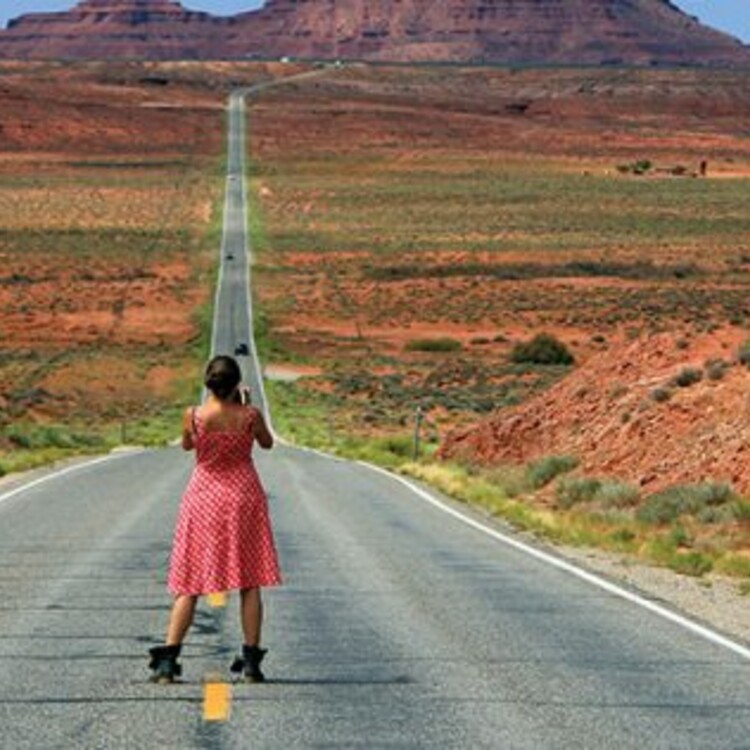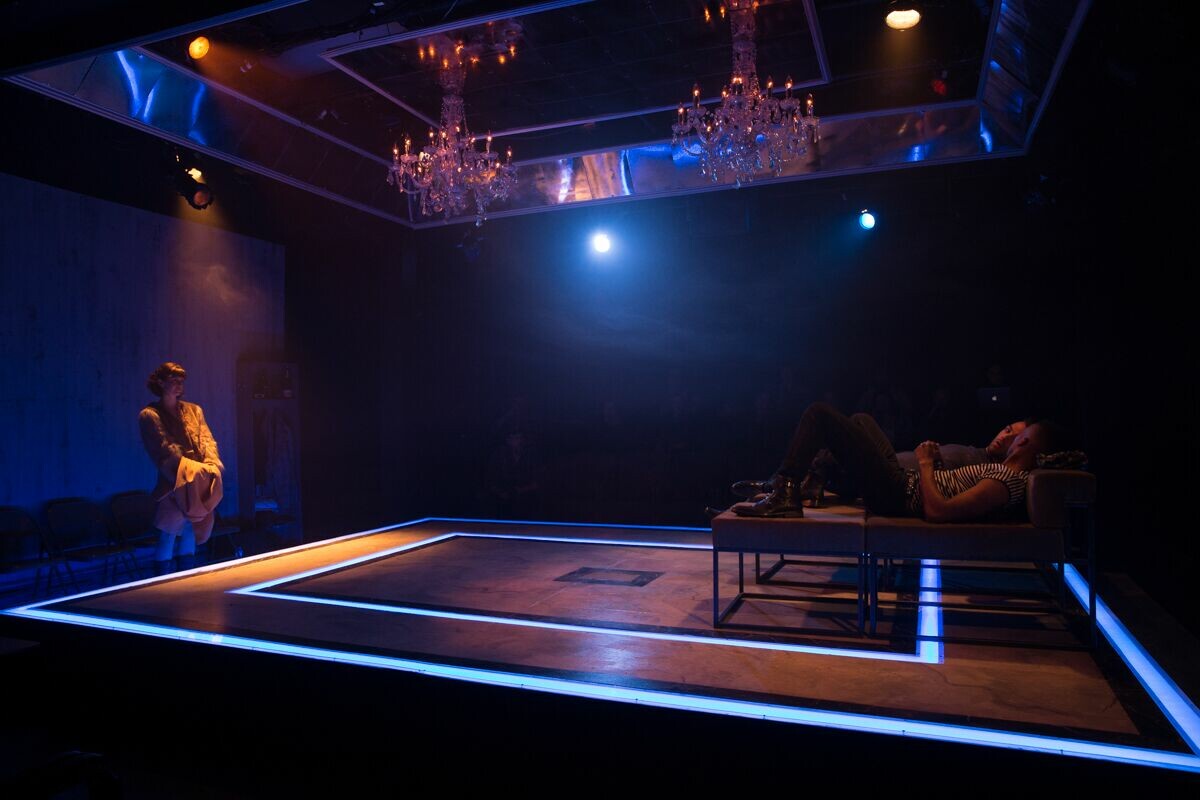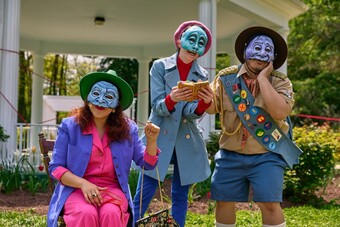Several years ago, I was invited to join a team of teachers for an introductory theatre class at a local college. We came together for a training, and the first task was to get to know each other. We sat around a large set of tables—some actors, some directors, some designers. The first eight or ten people to introduce themselves were all teaching voice or movement or acting, and each one of them shared their name, their role, and then something about their methodology. “I use Alexander technique,” “I trained in the LeCoq school,” or “I work with Viewpoints.” All the other people in the room nodded as they spoke. This shared vocabulary allowed the speakers to quickly share their philosophies about their work, allowed the listeners to understand our colleagues’ work, and allowed all of us to envision how we might work together. When it came to the first designer in the circle, she said, “Well, I’m a set designer, and I mean, I just do it?” Everyone chuckled and nodded, and every other designer in the room breathed a sigh of relief because it’s what we were all thinking too.
I’ve been “just doing” costume design for over twenty years, working primarily in academic and storefront theatre in Chicago, with over 120 productions on my resume. As a theatrical designer, my work is partly about my own artistic process, but it is also largely about collaborating with other people. In my time “just doing” this work, I have had collaborations that were smooth and some that were fraught; I’ve worked with directors who told me exactly what everyone should wear and directors who had no opinions about clothes. In all that time, what I did not have is a shorthand—a common language describing how I’ve been trained as a designer and my philosophy of design collaboration. Instead, a large portion of the unspoken work of each design meeting is figuring out what methods I have in common with my collaborators and where we differ. Can theatrical designers—and the directors we collaborate with—make this process easier and free up some energy for the work of making theatre?
For many designers, one easy way to be sure that you are working with a collaborative team that shares your methods and vocabulary is to collaborate with people that you trained with—to do most of your projects with artists who came from the same graduate or undergraduate program. I certainly followed this plan for my first few professional projects after completing graduate school at Northwestern. So the first time I worked with an Off-Loop company in Chicago (let’s call them Theatre A) that didn’t involve any of my MFA cohort, I was very nervous: What would they expect of me? How would they value my particular method of sharing research and design ideas, giving and receiving feedback, and participating in shaping the show?
In all that time, what I did not have is a shorthand—a common language describing how I’ve been trained as a designer and my philosophy of design collaboration.
That first experience with Theatre A was eye-opening. I had stumbled into a group of collaborators that shared and valued my working methods. For me, that meant sharing copious visual research with the full design team before starting sketches; getting and giving feedback about both my own and other designers’ work with the full team; and being present for the entire tech process as the show came together. As an emerging designer, I thought I had hit the jackpot.
The second time Theatre A hired me, they had a new artistic director, and the director of the show was new to me as well. I expected that collaborative process to go just as smoothly, but the institutional expectations of design collaboration had changed with the new personnel. I fumbled through that process, discovering at each step that now the director’s expectation was to share research and sketches primarily with the director only; that this production would prioritize set design before all other areas in shaping the show; and that my feedback and opinions both in pre-production and in tech were expected to focus solely on my own design area. There are designers for whom this collaborative method will sound very comfortable. For me, it was an unpleasant culture shock, and I did not work for that company again.











Comments
The article is just the start of the conversation—we want to know what you think about this subject, too! HowlRound is a space for knowledge-sharing, and we welcome spirited, thoughtful, and on-topic dialogue. Find our full comments policy here
we're extreemly happy having stumbled across this web site, it's really the thing my friend and I have been hoping for. The information on the website is truely needed and is going to help my friends and I while I am at work. It seems like everyone gained a lot of knowledge concerning the things I am interested in and the other links and info definitely show it. Typically i'm not on the internet most of the time but when I get a break im usually perusing for this type of factual information and stuff similarly concerning it. I have a couple of my family members that have also acquired a liking in this because of all that I have put together about it and they will more than likely to be visiting this website because it is such an excellent score. I am also facsinated in politics and how to deal with the new changes in politics. When you get a chance, check out at my site: Lynchburg Wedding Photographer
This is a great piece. Thank you so much for writing it!
Thanks for a great read!
“This perception that each collaboration is unique and therefore impossible to generalize about or categorize is getting in our way. It’s blocking our field from seeing commonalities between collaborative processes, and it’s preventing us from having clear conversations with our colleagues about how we would like our collective process to work.” I think you make a fantastic point here, and I’m really excited about your work to develop a common language in this space.
Emily, This is urgently needed. Took the words right out of my mouth, but said it better than I ever could have. At 60 it feels like I've now done every kind of collaboration process - Everything from the "Portlandia" method of getting set concept dictated by an Astrologist/Tarot Card reader in Oregon, to having an Artistic Director in Florida tell me "We only work in Pastels- And Designer Fabrics in our sets and High End Labels on the Costumes. . That's our Artistic Vision," (I think that system is called "Golden Girls Grotowski,--Towards a Rich Theatre."). I can't tell you how desperate I am for such a Taxonomy. Knowing the coin of the realm in advance would have saved me throwing out a lot of un-used set models. By the way, does anyone know the term for the amazing method that the Royal Shakespeare Company used In the 80s? According to several "Making Of," books They had the money to rehearse a play for FOUR WEEKS, then do a designer run, and then send everyone home for another Month while the Designers got to work on collaborating on a concept After they had seen a stumble through! The actors instincts then factored into the design process. Antony Sher saw Richard III as a Bottled Spider and the extended rehearsal process, and his own research, led him to play it on Crutches. Mark Rylance wanted to play most of Hamlet in Pajamas, so we'd know why he wasn't taken seriously by the court. Or the cast of Nicholas Nicholby got to figure out the "Story Theatre," methods first, before they were saddled with a realistic "Christmas Carol," type set. No Doors, No Walls, and one unit set. The collaboration process started with the team figuring out what what world of the play was first. The actor's voice in the design process that was then filtered trough an informed director's overall vision. But only after they had earned the honor of making their point in rehearsal. The question was always "Why is this group of Actors telling this story now, and what is this team trying to illuminate. All of those seminal productions were rehearsed extensively first and then designed after. And then rehearse for another four to six weeks. Please, Could someone in America endow a theatre where we can work that way? Please. I'm begging' Ya. I don't know of the exact name for that collaboration method, but I think it's called "Like I Died and Went to Heaven."